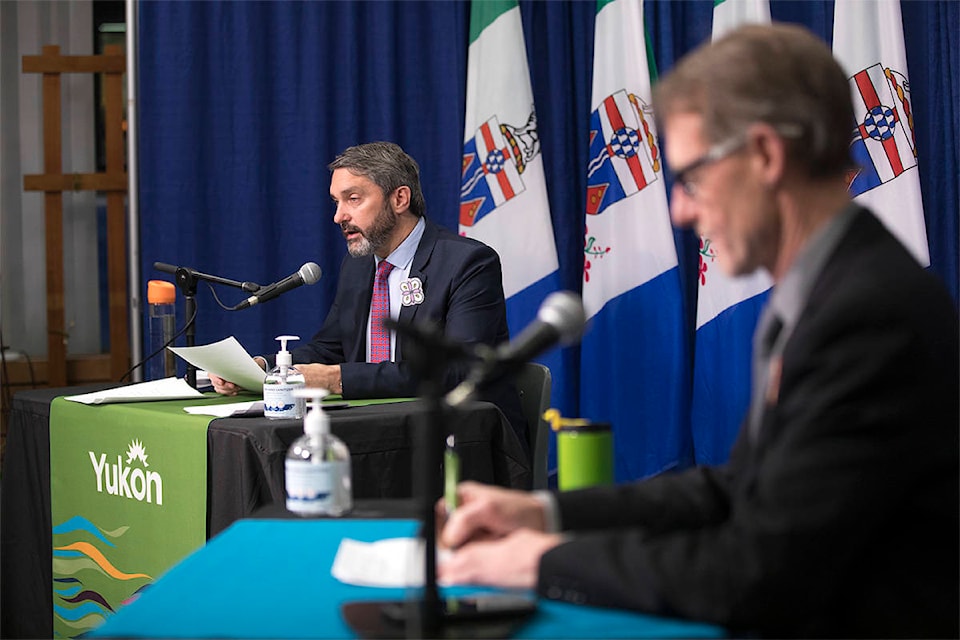As the Yukon’s case total edges upward to 58, Chief Medical Officer of Health Dr. Brendan Hanley and Premier Sandy Silver gave out holiday advice to Yukoners celebrating around town or welcoming friends and family for a visit.
The Yukon has seen an additional 10 cases since the last weekly update. The most recent three cases, confirmed on Dec. 4 and 5 but made public on Dec. 7 have been successfully traced back to previous cases and are recovering in self-isolation at home.
“I expect we will continue to see new cases emerge amongst contacts of cases today. This is normal until we can identify and isolate the last people in the chain of transmission,” Hanley said.
“We have not seen an explosion of cases over the last week. We’ve seen these little pop-up cases that are, for the most part, already known contacts or tied into the outbreak. So in other words, we’re doing pretty well,” Hanley added.
Hanley said all active cases are in Whitehorse except for the latest, case #58, which is in a rural community but traced back to the other cases. The government has decided not to reveal the location to the public, citing privacy concerns.
“The individual was a known contact and already self-isolating safely, and thus there is no risk to the public and the community associated with this recent case,” said Hanley.
As of Dec. 7 the government has also mandated that bars and restaurants keep a sign-in sheet for patrons in order to facilitate contact tracing. The businesses will be collecting names and contact information for each household.
The government said the information will only be used by Yukon Communicable Disease Control when required and will be disposed of within 30 days.
“We need to be as prepared as we can for further surges in case activity, or perhaps a widespread outbreak,” he said.
“We know that bars and restaurants can be higher risk areas of transmission, as it is an indoor setting where the public are able to mix. Now as people drink alcohol, the level of awareness may decrease, leading perhaps to a lack of physical distancing,” Hanley said, adding that people must remain vigilant and listen to staff and management.
Mandatory masks were implemented on Dec. 1. So far, the government has not laid any charges against individuals for failure to comply with the order. Thirteen complaints about failure to wear a mask have been received.
“I want to thank all of those who have been wearing masks in public. It’s very great to see. It signals that you care about your fellow Yukoners and want to keep them safe. We are absolutely not out of the woods yet,” Silver said.
The Yukon government has also extended the state of emergency an additional 90 days.
“The state of emergency may be cancelled at any time,” Silver said. “Though our government believes it may be required so long as the pandemic continues to pose a risk to the health, safety and the livelihood of Yukoners.”
Silver and Hanley also clarified the rules around self-isolation for those having visitors to stay for the holidays.
Right now visitors from Outside must isolate for 14 days in Whitehorse, unless they are a Yukon resident with a home outside the city or are isolating with a Yukon family member who lives outside the city.
The current advice is that Yukoners can either quarantine for 14 days with their guest or, if their home layout permits, can have their guest self-isolate separately from the family.
If a guest leaves before 14 days of self-isolation, the members of the household must self-isolate for three days afterward and monitor for symptoms. If the guest and the self-isolating family do not have symptoms after three days, self-isolation can end.
Hanley explained the shorter isolation period measures are based on the infectious period of the virus. Hanley said most people who contract the virus are still infectious up to three days before they exhibit any symptoms.
“I know we think of 10 days and 14 days and three days, and what’s the reason for all this? But really, it’s based on that three-day potential for transmission of disease in that pre-symptomatic period,” he said.
Contact Haley Ritchie at haley.ritchie@yukon-news.com
